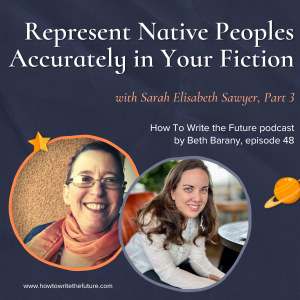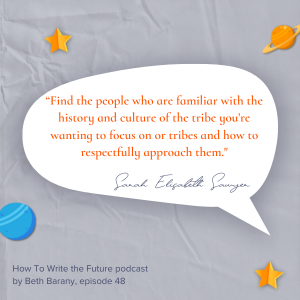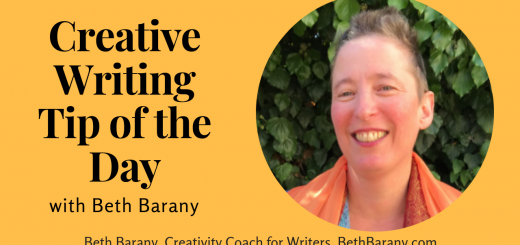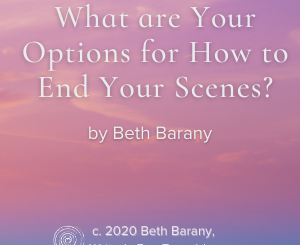Represent Native Peoples Accurately in Your Fiction with Sarah Elisabeth Sawyer, Part 3
In “Represent Native Peoples Accurately in Your Fiction with Sarah Elisabeth Sawyer, Part 3” host Beth Barany, creativity coach, and science fiction and fantasy novelist chats with author, writing instructor, and tribal member Sarah Elisabeth Sawyer where they discuss how to accurately and respectfully represent Native Peoples and their history in your stories and Sarah shares details of her course “Fiction Writing American Indians” and how it helps authors tell more authentic stories.
LISTEN TO PART 1, EPISODE 46 HERE: https://writersfunzone.com/blog/2023/05/22/represent-native-peoples-accurately-in-your-fiction-with-sarah-elisabeth-sawyer-part-1/
LISTEN TO PART 2, EPISODE 47 HERE: https://writersfunzone.com/blog/2023/05/29/represent-native-peoples-accurately-in-your-fiction-with-sarah-elisabeth-sawyer-part-2/
Platforms the podcast is available on Apple Podcasts | Google Podcasts | Buzzsprout | Spotify | Podcast Addict | Amazon Music | Youtube
RESOURCES
Free World Building Workbook for Fiction Writers: https://writersfunzone.com/blog/world-building-resources/
Sign up for the 30-minute Story Success Clinic here: https://writersfunzone.com/blog/story-success-clinic/
Get support for your fiction writing by a novelist and writing teacher and coach. Schedule an exploratory call here and see if Beth can support you today: https://writersfunzone.com/blog/discovery-call/
ABOUT SARAH ELISABETH SAWYER
Fiction authors who want to write about Native Americans face a challenging minefield riddled with dos and don’ts, and no clear answers. That is why author and writing instructor Sarah Elisabeth Sawyer created the “Fiction Writing: American Indians” digital course.
As a tribal member of the Choctaw Nation of Oklahoma, she has written and published 15 historical fiction books with Native main characters, and over 275 non-fiction articles on Native artists and organizations with representatives from dozens of North American tribes. The Smithsonian’s National Museum of the American Indian honored her as a literary artist through their Artist Leadership Program for her work in preserving Choctaw Trail of Tears stories, and she is a First Peoples Fund Artist in Business Leadership alumni.
Through her in-depth course, authors are equipped to write authentic stories that honor First American history and culture. Discover more at www.fictioncourses.com/americanindians
Free report “5 Stereotypes to Avoid When Writing about Native Americans” http://fictioncourses.com/stereotypes
Facebook: https://www.facebook.com/fictioncourses,
Instagram: https://www.instagram.com/fictioncourses/
ABOUT THE HOW TO WRITE THE FUTURE PODCAST
The How To Write The Future podcast is for science fiction and fantasy writers who want to write positive futures and successfully bring those stories out into the marketplace. Hosted by Beth Barany, science fiction novelist and creativity coach for writers.
Tips for fiction writers! This podcast is for you if you have questions like:
- How do I create a believable world for my science fiction story?
- How do I figure out what’s not working if my story feels flat?
- How do I make my story more interesting and alive?
This podcast is for readers too if you’re at all curious about the future of humanity.
TRANSCRIPT for Represent Native Peoples Accurately in Your Fiction with Sarah Elisabeth Sawyer, Part 3
Are you looking for a way to dig into your world building for your story?
Then I recommend that you check out my World Building Workbook for Fiction Writers. Now available.
It’s at How To Write The Future.com.
Just head on over there. Click, sign up. Put your name and email, and there you go. That workbook will be delivered to your inbox straightaway.
Hey everyone. Welcome back to How to Write the Future podcast.
The focus of this podcast and the focus of my work is to support writers to create positive optimistic stories because when we vision what is possible we help make it so. And part of that visioning is learning the tools of today that help us become better writers for tomorrow.
Welcome back to my conversation with Sarah Elisabeth Sawyer. If you haven’t yet, please do go back and listen to parts one and two, so you will be all caught up and then join us here for part three while I continue my conversation with Sarah.
Sarah Elisabeth Sawyer is a tribal member of the Choctaw nation of Oklahoma, and she has written and published 15 historical novels with Native main characters and has over 275 nonfiction articles on Native artists and organizations with representatives from dozens of North American tribes.
Please join us here for part three of our conversation, where we talk about her course on how to create accurate representations of native peoples in our science fiction and fantasy stories.
Enjoy.
Part 3 of Represent Native Peoples Accurately in Your Fiction with Sarah Elisabeth Sawyer
So, let’s talk about your course. You have a digital course called Fiction Writing American Indians.
How can your course help fiction writers?
And since my audience is mostly science fiction and fantasy authors, how can your course help us tell better, more authentic stories?
Maybe tell us a little bit about the structure of what people will learn and, if there’s assignments, or how does the course run?
SARAH ELISABETH SAWYER
Oh, I love that. I love the opportunity to share about it. It’s a course that I wanted to create for several years.
My mother told me, you need to do it. So I did. Finally.
She really encouraged me to put out all of the information that I’ve gained and learned over the years and share it with other authors cuz she’s like, they need it, they need that help.
And I was hearing that cry at conferences and at writing workshops of people who really lacked resources when it comes to writing about Native Americans or American Indians.
So I created Fiction Writing American Indians.
It’s a digital course and it’s self-paced. It’s about four hours long, but I broke it into bite size videos that you can consume again at your own pace.
And I did that because, as we’ve already been talking about here, this isn’t an easy topic. There aren’t quick yes or no answers. There’s not do it like this and you’re done.
It also gets heavy whenever we’re talking about historical trauma and the things that have gone on with my people for all of these years since first contact.
So, I deal with some heavy stuff, but it also again is broken into short videos so that you can consume them just a bit at a time, process ’em. There’s no writing assignments. You’re taking in the information. I give links and resources, so that you can take it and apply it to your own writing.
I start off with terminology, which we can touch on. And you touched on a little bit about First Nations with Canada.
A lot of people think it’s just completely taboo to say the word Indian. it’s actually not, but there’s certain context and ways of using it because it has been used as a derogatory term for so long.
So I spend about 45 minutes just on terminology because it’s such an in-depth and controversial. again creates fear. And I want to alleviate that fear. Also knowing that not everyone is going to agree. I talk about that, just so that authors have that heads up, have that view of how they can approach writing these stories.
Then I go into the practical. I go into how do you actually write and research native people?
This isn’t a study on Native Americans. It’s not an American Indians course, as in all about all the different tribes because there are over 500 nations here. I’m certainly not an expert in all of them.
And that would take years for you to go through something like that.
So this is more how to find the people who are familiar with the history and culture of the tribe you’re wanting to focus on or tribes and how to respectfully approach them; do your homework beforehand; to make contacts with reliable sources, hopefully within the tribe if you can; and learning to distinguish between what is a reliable source and what isn’t, and how to vet out those things because there’s controversy even among cultural experts.
And so I talk about how to deal with that, and what are the steps you can take, and what their responsibilities are as a writer. Which the short answer I could give is that you’re gonna do your research and do the best you can, and then that’s sometimes as far as you can take it.
So, I go through all of that.
I talk about stereotypes, which your listeners can go download my free ebook actually on five stereotypes to avoid when writing about Native Americans. You can find that at: fictioncourses.com/stereotypes, and that’ll take you directly to the ebook and you can download that.
I’ve gotten wonderful feedback on it. It’s not just a fluff download. it’s very short. You can read it in one sitting, but it gives you some very practical views of some stereotypes that we may not think about or a different way of thinking about them, and then what your solution is to avoid those.
So you can go download that again at fictioncourses.com/stereotypes. In the course I go more in depth in each of those five stereotypes, and I also cover seven more. So there’s a total of 12 stereotypes in there.
I go through again, resources, archives, tribal experts, and then I talk about how to attend native events such as a pow wow and what the protocols are.
So, cause I know, again, you have that fear element. You have that apprehension of, can you actually approach a native person and ask them questions?
So I believe there’s proper ways of doing that and ways that just in general, as authors, that’s going to get you the best results.
I say the best results. Sometimes though those are the more difficult aspects. So I go into that in the course and making those distinctions. It’s in part three parts.
So the first part is setting up the terminology and the difficulties in the past of the historical traumas of Native people and learning about them in a general sense.
And then I go into the writing and researching phase. That’s the big chunk where we’re really doing a lot of our work.
I end it with part three, and that’s publishing options. So I talk about the publishing journeys of my own books.
Some of the challenges that we’re having today in traditional publishing with non Natives who want to include Native characters. There’s controversy and there’s conflict there. So I talk about some of those issues and how you might address them in your publishing. I did have one of the authors who went through the course. She’s hybrid. She’s traditional and indie published. Her editor really wanted her to get a sensitivity reader for her Native characters.
She was cautious about that. I understand and I actually encourage authors to not go the sensitivity reader route. We can talk about that if you want. She told her publisher that she had taken my course, and so her publisher felt a lot more comfortable with the research and the work that she had put in to doing her story.
That’s not a guarantee that your publisher’s gonna be like, oh, you took the course, you get a free pass. But that is something that you’re showing people, your editors, your publishers, that you’re putting in the effort to do your research.
So in the course there we’re talking about publishing options and really helping authors go through that, the complete journey of if they’re going to tackle writing about American Indians, of how they can do that respectfully and go through the whole process from the understanding to the writing and research to the final publishing aspects.
BETH BARANY
That sounds wonderful. I love how you’ve broken that down into three parts.
I would like to talk about Sensitivity Reader because I actually did get some support with that in the current series because I have an important secondary character who uses Spanish.
I had never really done a sensitivity reader and I thought, This person was willing. And I should say also– caveat, I grew up here in Northern California where Spanish was spoken around me all the time, and my mother, like I said, was in Mexico as a child for six months, and she taught us basic Spanish, very basic, when I was a child.
I had that in the house as well as some other languages. My experience of it was eye-opening in that I was asked not to italicize my Spanish, my foreign words, specifically Spanish because it is so prevalent, so much more prevalent, especially here in California. I took that to heart because it is all around me. It’s also a part of my character’s life too.
So I realized, oh, this is just part of her every day. I don’t need to call it out. And that’s just one little switch that I decided to make after thinking about the feedback.
So I’m curious about your take on sensitivity readers. You were saying you don’t recommend it and maybe a little bit about that.
SARAH ELISABETH SAWYER
Sure. Yeah. That’s one of the things is I think it’s more coming down to the term and the idea behind it with sensitivity readers. What you did, and I know you probably got other feedback, and what I do encourage authors to do is to have cultural experts or people who are first in the culture, read your manuscript for things like that, for fact checking.
If you know basic Spanish and you use the term that you think’s okay. And they’re like, oh, that’s really just, if you’re like really familiar with someone, you wouldn’t just use that with a stranger. And you might have used it in that context. So I know whenever I was going through Spanish, that was one of the things with that.
With the italics, I know that’s been coming up even with Choctaw, I do still italicize, but typically just with the first instance.
And I mainly do that to let the reader know there’s a glossary. And if I can, I put the meaning of the phrase in the actual story so that they have that right there and they’re not taken out of the story.
So with sensitivity readers specifically, my concern is that, authors are relying very heavily on them. And I know of some authors who have scrapped their entire book. With that, and it may have needed that. I don’t know. I can’t judge that. I do know that with sensitivity readers, you’re only getting one person’s perspective, representing an entire culture and people. That’s my concern, is that you have one person who’s saying, this is offensive. You can’t include this, you should do that.
They’re only that one person speaking for an entire tribe, history, race, culture that has so much more. I don’t know that it could be contained in one person. And so that’s why I caution authors that before they scrap their manuscript or really trying to please one person’s perspective, you can get out of balance.
And you can, one, just have an unbalanced perspective in your story of that culture. And then two, end up unbalancing your story for the readers and taking away, some of the aspects that, that would’ve really impacted your readers in a positive way. So that’s my caution with the term sensitivity readers.
But I do encourage authors to, if they can have someone within the tribe read their manuscript, there’s a lot of language departments now and cultural departments, historic preservation departments. I work with all of those in the Choctaw Nation and they read my manuscripts before I publish.
I definitely encourage authors to get those eyes on there because again, you may have stereotypes in there that you had no idea it was a stereotype. You didn’t even know to ask or to research that.
So if you have the opportunity to have someone read it and point those things out, that is really gold. And I do encourage authors to do that.
BETH BARANY
That’s wonderful. What I hear you saying is it’s not just one person’s perspective you want. You want a multiple perspective. I really love what you said was the culture doesn’t reside in just one person.
I think that’s a big takeaway too, for people to realize that our cultures are made up of multiple people and the history. There’s just so many aspects.
SARAH ELISABETH SAWYER
Mm-hmm.
BETH BARANY
Yeah.
SARAH ELISABETH SAWYER
Mm-hmm. And sometimes it comes down to the family and how they were raised and there may be things that are specific to their family that’s not representative of the entire culture, or they’re missing those things from other families that are a part of the culture as a whole.
So, yeah, that’s why I encourage getting multiple perspectives#
BETH BARANY
That’s wonderful
So as we start to wrap up here, I was curious, can people approach you for coaching or consulting or a read through their manuscript?
In addition to your course, what other ways do you help writers?
SARAH ELISABETH SAWYER
That’s a great question. At this point, I don’t do one-on-one consulting, and I don’t do sensitivity reading or reading manuscripts because again, I’m, I’m Choctaw and that’s what I’m most familiar with is our Choctaw history and culture.
We talked a little bit about Lakota earlier. I do know some things about Lakota history and culture, but if someone came to me and they have a story with a Lakota character. I wouldn’t be qualified to give input or to give that kind of feedback.
One thing I am doing though, beyond my course, which I don’t know if even gave the address is – fictioncourses.com/AmericanIndians for the course. One of the things that I’ve added, to that– an additional training is my Native Reads Analysis Workshops
What I’m doing with those that’s being very beneficial for writers is I’m going through novels that have Native main characters. I’ve highlighted several sections.
This is when I say, someone is romanticizing American Indians. Here’s an example of this.
Or typically what I’m doing is I’m more on the positive side of here’s how they didn’t do that. And it was done really well in that, here’s where they don’t have that historical-only view, or here’s the wise guide, but it’s the grandfather and here’s the fresh way that they have twig snapping in the forest kind of thing.
So I’m like, here’s some good examples of how the author was able to incorporate the Native history and culture into that.
So my hope is to do a fantasy book, a Native reads analysis on that because I know, again, I have so many fantasy and sci-fi authors who reach out and contact me.
People are always free to email me. I do my best to answer questions and again, to alleviate some of those fears that authors have around writing Native characters because we need more people telling stories of hope and accurate stories of our tribal nations, our First Nations here, and first people of the land.
BETH BARANY
That’s wonderful. I love that. I’m so grateful that you could come onto my show today, onto my podcast.
As we close, is there any final remarks that you wanna encourage writers, any final pieces that we didn’t yet talk about that you’d like to end us with?
SARAH ELISABETH SAWYER
Oh, oh. I really appreciate you having out me on Beth.
And I will just leave authors with– and we think about the culture today and the controversies that surround writing about Native people, I encourage you to do your research, do your best writing, do everything you can. And then ultimately, I believe authors should be judged based on their writing and not on their race.
So regardless of what your heritage is, do your very best writing as you would for whatever story that you’re telling. And I hope the best for you. Do reach out to me if you have any questions and Yako key.
Thank you Beth, so much for having me on. This has been so fun.
SARAH ELISABETH SAWYER
Oh, thank you so much, Sarah. And everyone, please check out Sarah’s links.
Thanks for listening everyone.
That’s it for the third part of my conversation with Sarah Elisabeth Sawyer. I hope you enjoyed it. I hope you’ll contact Sarah with your questions. And I will see you in the next episode.
***
Thanks for listening everyone.
That’s it for the third part of my conversation with Sarah Elisabeth Sawyer. I hope you enjoyed it. I hope you’ll contact Sarah with your questions. And I will see you in the next episode.
Thank you so much, everyone for listening to my podcast. Your interest and feedback is so inspiring to me and helps me know that I’m helping you in some small way.
So write long and prosper.
Are you stuck and overwhelmed by world building?
Then check out my new World Building Workbook for Fiction Writers.
Head over to HowToWriteTheFuture.com and sign up for yours today.
Loved this episode? Leave us a review and rating here: https://www.buzzsprout.com/2012061
ABOUT BETH BARANY
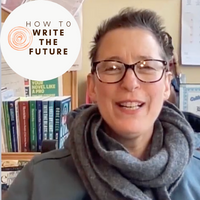 Beth Barany teaches science fiction and fantasy novelists how to write, edit, and publish their books as a coach, teacher, consultant, and developmental editor. She’s an award-winning fantasy and science fiction novelist and runs the podcast, “How To Write The Future.”
Beth Barany teaches science fiction and fantasy novelists how to write, edit, and publish their books as a coach, teacher, consultant, and developmental editor. She’s an award-winning fantasy and science fiction novelist and runs the podcast, “How To Write The Future.”
Learn more about Beth Barany at these sites:
Author site / Coaching site / School of Fiction / Writer’s Fun Zone blog
CONNECT
Contact Beth: https://writersfunzone.com/blog/podcast/#tve-jump-185b4422580
Email: beth@bethbarany.com
LinkedIn: https://www.linkedin.com/in/bethbarany/
CREDITS
EDITED WITH DESCRIPT: https://www.descript.com?lmref=_w1WCA
MUSIC: Uppbeat.io
DISTRIBUTED BY BUZZSPROUT: https://www.buzzsprout.com/?referrer_id=1994465
SHOW PRODUCTION BY Beth Barany
SHOW NOTES by Kerry-Ann McDade
***
For more “How To Write the Future” episodes, go here.
If you’d like to invite Beth onto your podcast, drop her a note here.

